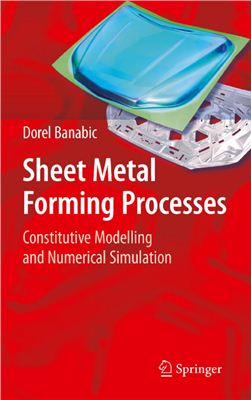Berlin - Heidelberg: Springer-Verlag, 2010. - 318 pages. Язык -
английский. The book gives a synthetic presentation of the research
performed in the field of sheet metal forming simulation during
more than 20 years by the members of three inteational teams: the
Research Centre on Sheet Metal Forming - CERTETA (Technical
University of Cluj-Napoca, Romania); AutoForm Company from Z?rich,
Switzerland and VOLVO automotive company from Sweden.
The concept of virtual manufacturing has been developed in order to increase the industrial performances, being one of the most efficient ways of reducing the manufacturing times and improving the quality of the products. Numerical simulation of metal forming processes, as a component of the virtual manufacturing process, has a very important contribution to the reduction of the lead time. The finite element method is currently the most widely used numerical procedure for simulating sheet metal forming processes. The accuracy of the simulation programs
used in industry is influenced by the constitutive models and the forming limit curves models incorporated in their structure. From the above discussion, we can distinguish a very strong connection between virtual manufacturing as a general concept, finite element method as a numerical analysis instrument and constitutive laws, as well as forming limit curves as a specificity of the sheet metal forming processes. Consequently, the material modeling is strategic when models of realityhave to be built.
The concept of virtual manufacturing has been developed in order to increase the industrial performances, being one of the most efficient ways of reducing the manufacturing times and improving the quality of the products. Numerical simulation of metal forming processes, as a component of the virtual manufacturing process, has a very important contribution to the reduction of the lead time. The finite element method is currently the most widely used numerical procedure for simulating sheet metal forming processes. The accuracy of the simulation programs
used in industry is influenced by the constitutive models and the forming limit curves models incorporated in their structure. From the above discussion, we can distinguish a very strong connection between virtual manufacturing as a general concept, finite element method as a numerical analysis instrument and constitutive laws, as well as forming limit curves as a specificity of the sheet metal forming processes. Consequently, the material modeling is strategic when models of realityhave to be built.

